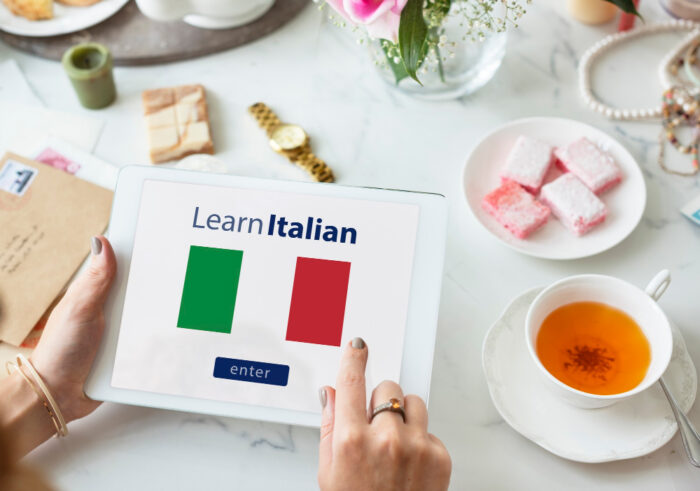
Embarking on the journey of mastering Italian, a language known for its richness and expressiveness, presents a mix of rewarding experiences and challenges. Italian, a Romance language, offers a gateway to experiencing the vibrant Italian culture, art, history, and cuisine. For those embarking on their language-learning journey, discovering the best way to learn Italian is crucial.
This guide provides the best strategies and tips to learn Italian effectively, whether you’re a beginner or looking to enhance your existing skills.
Starting Your Italian Learning Journey
Embarking on the path to learn Italian can be thrilling. With its melodious sounds and rhythmic intonation, Italian often captivates language learners. As a first step, learning the basics of the Italian language, such as understanding the Italian alphabet and simple phrases, lays a strong foundation. For beginners, getting accustomed to the Italian sounds and the basic vocabulary that will be the building blocks of your learning is essential.
The Importance of Italian Grammar
Italian grammar, though different from English, shares many features with other Romance languages. A solid grasp of Italian grammar is vital for anyone who speaks Italian fluently. Start with the basics, like nouns, verbs, and adjectives, and gradually move to more complex structures. Remember, understanding the nuances of grammar is key to expressing yourself correctly and confidently.
Integrating Italian Vocabulary
Building your Italian vocabulary is a core aspect of learning Italian. Start by learning the most common Italian words and phrases used in everyday situations. This practical approach helps quickly acquire the language skills necessary for daily communication. Additionally, learning new vocabulary in the context of sentences rather than in isolation can significantly enhance retention and understanding.

Immersing Yourself in the Language
The Power of Language Immersion
To truly learn Italian, immerse yourself in the language as much as possible. Language immersion accelerates learning and helps you understand the cultural nuances that come with language. Watching Italian TV shows, listening to Italian audio lessons, and engaging with Italian speakers are excellent ways to immerse yourself. Even dedicating time during your lunch break or morning coffee to study Italian can be incredibly effective.
Speaking Italian: Practice Makes Perfect
The goal of learning Italian is to be able to speak Italian fluently. Practice speaking as often as you can. Don’t be afraid to make mistakes – they are a natural part of the language-learning journey. Try to find language exchange partners or hire online tutors to practice speaking. Remember, the more you speak, the more comfortable you will become.

Leveraging Technology in Learning Italian
In today’s digital age, numerous resources are available for those wanting to learn Italian. Online Italian courses offer structured learning paths and are a convenient way to learn, especially for those with a busy schedule. Android apps and various language learning websites can also provide interactive and fun ways to enhance your Italian learning experience.
Italian Audio and Visual Aids
Italian audio lessons and watching Italian movies are fantastic ways to improve your listening skills and pronunciation. These resources help you get accustomed to the rhythm and flow of the language, making it easier to understand and speak Italian. Audio lessons are particularly helpful as they can be listened to on the go, making them a great resource for learners with a busy schedule.
The Role of Italian Culture in Language Learning
Understanding Italian culture is an integral part of learning the language. The language is deeply connected to its culture, and having an appreciation for Italian art, history, and traditions will enrich your language-learning journey. Immersing oneself in Italian culture through films, books, and music enhances the understanding and appreciation of this expressive language.
Mastering Italian effectively entails grasping fundamental elements like grammar and vocabulary, engaging in consistent practice, and deeply immersing in both the language and its culture. Each learner’s journey is unique, and finding the methods that work best for you is key. Stay motivated, practice consistently, and most importantly, enjoy the beautiful journey of learning la bella lingua.

Advancing Your Italian: Strategies and Resources
Continuing your journey to learn Italian, you must delve deeper into specific strategies and resources that can facilitate your learning process. This section will explore how Italian lessons, interaction with native speakers, and various learning tools can significantly enhance your proficiency in this beautiful language.
The Role of Structured Italian Lessons
Enrolling in Italian lessons is a fantastic way to structure your learning. Whether you choose online courses or in-person classes, lessons provide a comprehensive approach to understanding the intricacies of the Italian language. They often cover many topics, from Italian nouns to complex sentence structures, ensuring a well-rounded learning experience. Language lessons are typically structured to accommodate learners at different skill levels, from novices to those more advanced.
Harnessing the Power of Native Italian Speakers
One of the most effective ways to learn Italian is by interacting with native Italian speakers. This interaction provides an invaluable opportunity to practice speaking and listening to the language in its most authentic form. Engaging with native speakers helps you pick up on nuances such as colloquialisms, accents, and real-life language usage that textbooks might not cover. It’s a fantastic way to gain confidence in your speaking abilities and to understand the cultural context behind the language.
Exploring the Italian Alphabet and Pronunciation
A fundamental step in learning Italian is mastering the Italian alphabet. Understanding the alphabet is crucial as it forms the basis of Italian pronunciation. Unlike English, Italian is a phonetic language, meaning it is spoken the way it is written. This characteristic makes learning Italian pronunciation a more straightforward task. Paying attention to the pronunciation of Italian vowels and consonants, especially those sounds that don’t exist in your native language, is key.
Italian Nouns and Grammar
Getting a grip on Italian nouns and their corresponding articles is essential. In Italian, nouns are gendered and can be either masculine or feminine, affecting the form of the articles and adjectives used with them. Learning these rules early on can significantly improve your grammatical accuracy and understanding of the language.
Embracing Slow Italian for Better Comprehension
Listening to spoken Italian can be overwhelming for beginners due to its speed. Engaging with resources that offer ‘slow Italian’ can be extremely beneficial. This method involves listening to spoken language slower, making it easier to identify words and understand sentence structures. It’s an excellent way for beginners to improve their listening skills without feeling discouraged by the natural speed of native speakers.
Italian Audiobooks: A Multifaceted Learning Tool
Incorporating Italian audiobooks into your learning routine is a fantastic way to immerse yourself in the language. Audiobooks provide exposure to varied vocabulary, different accents, and the rhythm of the language. Moreover, the availability of online lessons adds convenience, perfectly suiting those seeking to integrate language learning into a hectic lifestyle. Listening to stories or subjects you enjoy in Italian can make learning fun and effective.
Learning Italian as a Foreign Language
The pursuit of Italian as a second language is a path filled with both obstacles and triumphs, demanding commitment, consistent practice, and an eagerness to dive into a novel linguistic and cultural realm. To overcome these challenges, staying motivated and being consistent in your learning efforts is crucial, as finding joy in the small victories of understanding and communicating in Italian. Remember, each new word, expression, or grammatical concept mastered is a step closer to fluency in Italian.
The journey to learn Italian is as rewarding as it is challenging. By engaging in structured lessons, interacting with native speakers, and utilizing diverse learning tools such as audiobooks and slow Italian resources, you can significantly enhance your proficiency in this beautiful foreign language. Bear in mind, language acquisition isn’t merely about memorizing vocabulary and grammar; it’s about adopting a new mindset and gaining insight into a distinct culture. Stay curious, stay motivated, and enjoy the journey of becoming fluent in Italian.

Tailoring Your Italian Learning to Your Style and Goals
Embarking on a language journey is a deeply personal experience, and tailoring it to suit your learning style and goals can significantly enhance your ability to learn Italian. This section will guide you through strategies to align your learning with your preferences and objectives, ensuring a more enjoyable and efficient journey towards fluency in your target language.
Understanding Your Learning Style
Everyone has a unique learning style, and recognizing yours can be a game-changer in your learning of Italian. Some learners find visual aids like charts and videos helpful, while others prefer auditory methods such as listening to Italian audiobooks or podcasts. Kinesthetic learners might benefit from hands-on activities like cooking classes in Italian. Experiment with different approaches and find what resonates with you. Adapting your study methods to your personal learning style can make the process more engaging and effective.
Language Journey: Making it Personal and Enjoyable
Setting achievable goals and celebrating every small milestone is crucial in the language learning journey. Whether mastering a complex grammatical structure or having a complete conversation with a native Italian speaker, each achievement is a step forward. Remember, the journey to fluency is not just about the destination but also the growth and experiences along the way.
Focusing on Practical Phrases and Speaking Skills
The ability to communicate in everyday scenarios stands as one of the most gratifying outcomes of learning a new language. Focus on learning practical phrases that you can use in real-life scenarios. This not only boosts your speaking skills but also your confidence in using the language. Engage in conversations, practice with native speakers, or even record yourself speaking. The more you practice, the more natural your speaking skills will become.
Complete Lessons: Building a Strong Foundation
Enrolling in complete lessons, whether through a language school, online courses, or self-study materials, provides a structured approach to learning Italian. These lessons often cover various topics, from basic grammar to advanced conversation skills, ensuring a comprehensive understanding of language. They also provide a sense of progression, which can be incredibly motivating for language learners.
Aligning with Your Target Language
Align your learning activities with the specific nuances of your target language – Italian. This means not only focusing on vocabulary and grammar but also on cultural aspects, idiomatic expressions, and regional variations within Italy. Understanding these elements is crucial to gaining a deeper, more nuanced understanding of Italian.
Language Journey: Reflecting on Progress
Regularly reflect on your progress in your language journey. Assess what learning strategies work for you and what areas need more attention. Such introspection is vital for ongoing progress and enables the fine-tuning of your study strategy to align with your personal needs and objectives.
Leveraging Your Native Language
Use your native language to your advantage. If your native language shares similarities with Italian, such as being a Romance language, leverage that to understand grammar and vocabulary. If your native language is quite different, use that perspective to explore and appreciate the unique aspects of Italian.
Personalizing your Italian learning experience according to your learning style, focusing on practical usage, and engaging in complete lessons are key to effectively mastering the language. Remember, learning Italian is a journey that requires patience, practice, and passion. Fully embrace every facet of Italian language and culture, reveling in the enriching journey towards fluency.

Enhancing Italian Fluency: Advanced Techniques and Resources
Exploring advanced techniques and resources becomes crucial for continued improvement and fluency as you progress in your Italian learning journey. This section focuses on strategies for dealing with unfamiliar words, using multimedia resources like YouTube videos, and practical tips to start speaking Italian more fluently.
Tackling Unfamiliar Words and Phrases
Encountering unfamiliar words is a common part of learning a new language. When you encounter new Italian words, try to understand them in context first. This approach often provides clues about their meaning and usage. Keep a notebook or digital tool handy to save words and their meanings for later review. Regularly revisiting these words helps gradually expand your vocabulary and understanding of Italian.
Utilizing Context to Grasp Meaning
Sometimes, words in Italian may have the same meaning as words in other languages, especially closely related ones. Recognize these cognates to expand your vocabulary more quickly. However, be mindful of false cognates – words that look similar in two languages but have different meanings.
Reinforcing Learning with Earlier Lessons
Revisiting earlier lessons is a valuable strategy for reinforcing what you’ve learned. It helps in consolidating your understanding and ensuring that the foundational aspects of the language are deeply ingrained. This practice can also boost confidence, as you’ll likely find these earlier lessons easier the second time, demonstrating how much you’ve learned.
Leveraging YouTube Videos for Interactive Learning
YouTube is a goldmine of resources for language learners. From Italian language tutorials to vlogs by native speakers, YouTube videos offer a variety of content to enhance your learning. They are useful for improving listening skills and adapting to different Italian accents and speaking styles. Additionally, many YouTube channels provide interactive lessons that are both informative and engaging.
Starting to Speak Italian
One of the most crucial steps in learning Italian is to start speaking the language. Begin with simple phrases and gradually build up to more complex sentences. Don’t worry about making mistakes; they are integral to the learning process. Speaking Italian regularly, even if it’s just narrating your daily activities in Italian, helps build confidence and fluency.
Engaging with Italian Texts
Reading Italian texts, ranging from news articles to novels, is an excellent way to improve language skills. It enhances your reading comprehension and exposes you to new vocabulary and sentence structures. Try to read various texts to broaden your understanding and keep the learning process interesting.
Practical Tips to Enhance Speaking Skills
To enhance your speaking skills, practice with native speakers as much as possible. This could be through language exchange meetups, online tutoring, or conversation clubs. Record yourself speaking Italian and listen back to identify areas for improvement. Focus on pronunciation, intonation, and fluidity of speech.
Consistent Practice and Review
Consistency is key in language learning. Make it a habit to engage with the Italian language daily. Regular practice is essential for making steady progress, Whether through reading, listening, writing, or speaking. Also, periodically review saved words and phrases to reinforce your memory.
Advanced learning techniques, such as tackling unfamiliar words, leveraging multimedia resources like YouTube, and engaging in consistent practice, are essential for fluency in Italian. Remember, language learning is a journey that evolves over time. Stay curious, be patient with your progress, and enjoy the rich experience of learning this beautiful language.

Embracing Italian Culture: The Final Piece of the Puzzle
As you approach the end of this comprehensive guide on learning Italian, it’s important to recognize the invaluable role of cultural immersion. Understanding and embracing Italian culture is not just an enhancement to your language learning; it’s a critical component. You deepen your connection with the language by experiencing the rich tapestry of Italian art, music, history, and traditions. This cultural journey brings the language to life, transcending words and grammar. Whether it’s preparing authentic Italian dishes, delving into Italian literature, or participating in cultural events, each activity deepens your understanding and appreciation of the Italian language.
Remember, learning Italian is more than just acquiring a new set of linguistic skills. It is a journey into a world of historical richness, artistic beauty, and cultural depth. Stay curious and open-minded, and let your passion for Italian guide you through this fulfilling journey. Every effort you put into learning this beautiful language brings you closer to fluency and a deeper understanding of a culture that has shaped the world in countless ways.
Frequently Asked Questions
How can I learn Italian by myself?
You can learn Italian by yourself by utilizing resources like online courses, Italian textbooks, and language learning apps and practising regularly. Engaging with Italian media, such as movies, music, and books, also aids in self-learning.
Can I learn Italian in 3 months?
Achieving basic conversational fluency in Italian in 3 months is possible with intensive study and practice. However, mastery of the language requires ongoing learning and immersion.
Is Italian hard to learn?
The difficulty of learning Italian varies based on your native language and language learning abilities. Italian may be easier for speakers of other Romance languages, while it might present more challenges for those with different linguistic backgrounds.
Is Duolingo the best way to learn Italian?
Duolingo is a helpful tool for learning Italian basics and practising daily. Still, it’s most effective when combined with other methods like speaking practice, cultural immersion, and structured lessons for a comprehensive learning experience.








